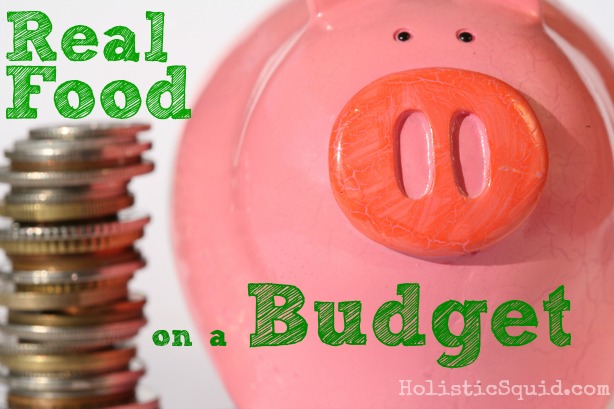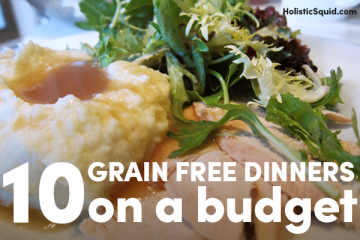
Tee hee. [nervous giggle] Do you think I actually have an answer to that? Well…
“This is the year of fiscal conservation” – or so says my husband.
Hmph. I've never been one for budgets, and while I don't fancy myself an extravagant shopper (no Manolo pumps or Louis Vuitton hand bags in my closet), I do have a weak spot for home decor, and you guessed it, real food.
Folks ask all the time, “How can you afford to eat like that?” – Referring to a traditional foods diet packed with grass-fed, local meat, eggs, and dairy, farm box veggies, and a few imported staples like coconut oil and good sea salt.
My retort is usually, “How can you afford not to?” – Referring to the ill effects of the standard American diet and cheap food on human health.
Well, with my nose in the air, I have stuck to my guns about our household food expenditures. It's been my belief that my family's health is worth every penny that we spend on food, and I wasn't willing to discuss cutting back one bit.
Then, in the spirit of ‘fiscal conservation' I looked at the numbers.
On average last year we spent $1500 per month on groceries (and $2272 total food cost) for a family of four – two adults and two big eaters under the age of six. The national average is estimated to be $1013.80 per month for a family of 4 according the the USDA's ‘liberal' plan. Gasp. Oh, dear. I suppose I may need to limit the number of eighty dollar bags of goodies I buy at Whole Foods.
I'll admit, it certainly would be nice to cut our food bill in half – I am plotting ways to spend the imaginary savings already! I'm still not willing to compromise on the quality of my family's food, but I sure do love a nice competition. Me versus the food budget. Bring it.
I've been nosing around the blog-o-sphere and have found plenty of inspiring ideas and interesting tips for feeding your family Real food whilst on a budget.
My favorite penny-saving tips for real food on a budget
Shop less – Last year, Brenda from Wed Fed Homestead, did 3 months of no shopping. I'm not sure I can commit to NO shopping, but with my new freezer packed full, I'm excited to see how little I can spend by eating the food I already have.
Don't double up on protein – I do love eggs and bacon for brekkie, but in a effort to save money, it doesn't make sense to “pair meat with cheese, eggs with cheese, meat with eggs, and the like unless I'm cooking up something special.” This advice and the tip that follows are from Food Renegade.
Eat more veg – As a traditional foods advocate, it's not often that I get on a soap box about eating more veggies. Don't get me wrong, I do love some wilted kale or steamed asparagus (both with butter, of course), but I just know they don't pack as much nutritional punch as high quality fat and meats.
BUT, to save money without gorging on tons of grains, a big serving of veggies (smothered in fat and accompanying my protein) is a great way to fill your tummy.
Make meal plans – I swore I would never do this (it always seemed so tedious), but now I can see how planning the week's meals in advance will save us from those last minute restaurant lunches or expensive trips to the grocery store.
I will share my meal plans in the coming weeks so we can compare notes.
Don't go it alone – I love the idea of banning together as a community to save money while eating great food. Frugally Sustainable has hundreds of people committed to a Frugal Living Challenge. I'm looking forward to her tips on savvy saving.
So, it's decided:
This is the year of real food done frugally
Join me on my adventure.
I'm planning to dump my purse on the floor for the whole world to see, and I'm determined to eat amazing food for the same budget that the US government considers a ‘liberal' plan.
Watch me fall flat on my face a few times, and hopefully come out the other side well-nourished with a few more bucks in my piggy bank.
Care to share your tricks for saving money while eating great food? I need all the help I can get!












This is my favorite post so far, love your husband. 🙂
A big huge thank you for the shout out and link to our 23 Day Frugal Living Challenge! It should be a great start to the New Year:)
Looking forward to hearing your tips, Andrea!
Good timing, I am going to be doing this myself!
A few of the things I am working on:
using up what is on hand
more soups
organ meats (seriously. $5 can buy a pound of grass fed liver. I am in a house with only two adults. That’s two meals. $1.25 per person for protein. And I hope to add more organ meat it.)
making more lacto-fermented veggies. (There is a northeast brand called Real Pickles which I love, but the cost per jar is 2-3 times the cost to make it myself. Time to stop being lazy.)
More veggies! Which means buying more and coming up with ways to cook them.
More seafood.
At least one meal a week which is egg or cheese based and not meat.
It’s also going to be tough since the other adult in the house does low carb so stretching with bread, rice, etc. isn’t quite an option.
Hi Soli – I too do low carb, and I’m planning to eat lots of spaghetti squash and cabbage. I need to double check, but I feel like the liver we buy isn’t cheap. Though it IS mixed in with ground beef, so perhaps I’m paying for the convenience of not having to do it myself. Glad to have you as a partner in frugality!
Wow, now I feel so much better about how much I’m spending on my own family of four! I try very hard to keep it to $800, but I’m usually in the $900 to $1000 range. I’ve been able to get it down a little by making a lot more soups. Thank you so much for putting this out there. I’m a fairly new reader and I’m looking forward to future posts.
I am so curious to figure out how I manage to spend so much on food. I make gallons of soup. But perhaps we need to eat more! I am aiming for your budget.
LOL at Antony’s comment!
My mom always says the best relationships are the ones in which one person is the brakes and the other is the gas. Often the women are the gas, but not always.
Clearly both Seth and Antony are the brakes and you and I are the gas.
I am willing to cut our food costs. I need to find an Azure Standard drop here in Vegas. And buy a side of grass-fed beef.
But I’m going to start spending MORE on a housekeeper/cook. I just can’t do it all and I don’t have time to do all this cooking. I’ll make sure the cook is tax-deductible.
I can’t decide if it’s worth it for us to buy a side a beef or just stock up on the cheaper cuts that we prefer to eat anyway. Have you ever done a cross comparison of this?
Oh! And I have to get a small chest freezer first before I can get the meat.
You have to spend money to make money!
OK now I feel a lot better about my food budget 😉 We are a family of three. My baby just started eating solids. We were spending $250 a month on food and now have bumped it up to $400, which we feel very guilty about!!! If you come up with more money saving tips on your journey, please share them!!! As much as I WHOLEHEARTEDLY agree with you that you can’t afford NOT to eat right, the fact remains that if the money isn’t there, you can’t spend it. I think we’re doing well for the amount of money we can spend, but there are still so many changes I would like to make to our diet!
Hi Melissa – Wow! I am amazed at your budget – great job. I wonder how much of my inflated budget has to do with living in Los Angeles. Is the cost of food much different in different parts of the country? It’s not like we are eating filet mignon and caviar…
Melissa – I realize this post is pretty old, but I just came across it and I wanted to let you know we are in the same situation! A family of three with a 14-month-old who eats almost as much as I do, and our budget is $425/month. It’s definitely hard to stick to, and our options are very limited when it comes to buying grassfed meats and pastured eggs and the like. Supplements like probiotics aren’t included in our food budget, we have to save up extra for those every other month or so 🙂 It’s hard when you want to feed your family the best you can, but you just can’t afford it! I am comforted by reminding myself that I’m doing the best I can with what I have, and that it’s miles better than what most of the people around me are doing!
Emily, I would love to hear some more ideas for low carb meals. Is spaghetti squash really that low?
Earlier this year I saw a posting on Nourished and Nurtured for using zucchini as a pasta and that was great over the summer.
LOVE this post!!! i am always thinking about how i can reduce our budget without compromising the food we eat (grass fed, organic, etc). i can find organic, pastured, grass fed beef for $6 a pound at our local farmer’s market which helps! i will say that meal planning makes a huge difference. and taking inventory of what you have on hand to use before going grocery shopping also helps. thanks for a great post!
I think it’s wonderful that you have the budget you do to work with! As long as you can afford it, then of course real food is a wonderful ‘bang for your buck’ investment.
However, as someone with a family of eleven and a monthly budget of $550 – and I squeeze a maximum amount of nutrition out of that – I cringe when someone says something like, “How can you afford not to?” I agree that good nutrition is paramount. But so often people feel like those in the real food movement are elitist because of statements like this, and it ignores the reality of many, many families who just don’t have the USDA liberal – or even super minimal – budget to work with.
My tips? I have oodles of them, as you can imagine by my budget :P, but here are a couple of biggies: Buy in bulk, buy direct from the source, cook everything from scratch, buy only what’s in season, don’t shop with a list but rather stock up on what’s on sale, build your pantry, know where to compromise, and don’t feel guilty when you’re doing the best you can!
Lots of luck!
Avivah
We’re a family of 7, and typically we spend $500 to $600 monthly on food. We eat a lot more conventional meat than you probably do, and certainly, we don’t spend $9 to $10/lb. on local cheese. I’ve been working on our real food diet for awhile, and I still have a lot to learn. My biggest hurdle is finding sources for food. I simply don’t have the time to shop all over the place.
I’m looking forward to the frugal challenge, too!
We are a family of 9 (soon to be 10) and have found our “real food bill” hitting the roof. I try to limit the portion size and eliminating snacks has helped. When we are eating the right foods I find my children are rarely hungry for more than one portion (my husband on the other hand is a junk food eater and is rarely satisfied with what he consumes). I’ve also found we spend very little money on health care needs, years ago we were at the ped. office at least twice a month and the past year it has only been for well visits.
With all this said my children are growing quickly so we’ve moved to a farm for the sole purpose of feeding our family. Not sure how much it will save us since it takes $$$ to raise and feed animals naturally. My only response to those who question our “indulgence” in real food is “I’m simply following my ‘gut’ when it comes to nourishing my family.”
Thanks for this post!
I”m sorry Emily, I just saw your question! Yes, we live in Great Falls Montana, and I do believe the cost of living is cheaper here all around. Also we don’t have sales tax. However, I just shared some of my money-savings ideas on your most recent post. Organ meats, replacing meat with dairy products made at home, frozen wild-caught fish, and beans 😀
Thanks for this post, I have been feeling bad for our $750-$1000/month food budget for two adults and two young children. But I guess I am doing okay :/ Though I would love to be able to cut more and save more. Some of the major things I do to save money is lots of preserving, order from Azure, buy meat and grains in bulk when I can, and I am a member of a herd share for our raw milk and a CSA in the summer for our veggies. Our local WAPF Chapter also has a buying club through a cheese company to get raw cheese and grass fed butter and a pretty darn good price.
I dont know if this will help you, but I recently posted a blog on my own pages about what I do to save money with food. And Ive asked others to please add to the list in the comments if they have ideas that I havent put on the page. After all we all can use the help today. http://mermaidstreasures.blogspot.com/2011/11/being-frugal.html
I have no choice now but to cut back, we are both not working. But I knew this might be coming so I planned to have backup on my shelves and canned alot of things for the future. So while I spent more money back then, Im able to save it now cuz I only need to buy the basics now. However I started doing this knowing this was coming cuz I too saw my food bill and freaked. After all there is only two of us here. But to be honest, no matter where you are or what you spend, everything is going way up too. So you can only cut back so much and it still hurts.
Recently while visiting a second hand store there was a really nice cheese shredder that was brand new, never used that I picked up for $1.00. Not thinking it would be used much since I am dairy free, but the kids do like shredded cheese because it looks like ‘little worms.’ Well, I have been in awe at how much use this gadget has been! It has a handle and makes my life SO much easier, easy to clean. Not to mention how much money has been saved on cheeses. The kids are happy to have the shreddy cheese and it stretches it so much further that it saving big $$. That 1.00 gadget was a treasure for this Mama:-)
My DH and I plan $400 per month for food; we usually end up spending between $400-$500. We have one baby who is not a big eater. My main tip is to eat a lot of lentils! Seriously, we love meat – LOVE – but limit it to once or twice a week – Sunday, because it’s a special day, and usually Wednesday, when we enjoy a midweek meaty meal. 🙂 Cooking with beans and lentils bought in bulk saves a bundle!
I appreciate this post and look forward to more. We are on ‘food stamps’ and it’s hard to eat well when I am not able to buy from farmers, most farmer’s markets, or online.
I’m also attempting to get our food budget down from $400 a month for just me and my husband. Things I’ve done so far:
1. Stopped buying food at work. I work at a grocery store with a hot food bar and instead of shelling out $2-5 per break (I get two and I have a stupidly high metabolism so I’m usually hungry for both) for overpriced crappy “food” I keep a bowl, spoon, bottle of raw honey, and a gallon of whole milk up in the breakroom and I soak a portion of steel cut oats each night to eat for breakfast on my first break. I also try to bring leftovers or raw veggies for my second break. This by itself saves a ton of cash every month.
2. Stopped buying bread. I bought a bread machine for $5 at Goodwill and now make all my own bread. I taught my husband how to do it too, so he can make it while I’m at work if we run out (he works from home). This saves us from shelling out $5 a loaf for good bread at the store.
3. A gallon of Organic Valley whole milk is now $7.50 where I work, and I go through one a week. I’m currently looking into an alternative because $30 a month just for milk for one person is just too much. What complicates this is that making my oatmeal with just water pretty much means I’ll be hungry again in 30 minutes. I need a replacement source of fat and protein that’ll keep the calorie content of the meal up around 700-800 (Yes, that is how many calories I typically consume with breakfast each morning between the oats, honey, and milk). I’m working on this one.
4. I make my own stock and save vegetable scraps in the freezer to put into it.
5. I don’t buy snack foods or drinks other than milk. Snacks in our house mean raw veggies or a slice of homemade bread with butter and a few cubes of cheese, and if we’re thirsty it’s water, milk, coffee, or tea.
6. I’m looking for a local source of pastured eggs that don’t cost me $4 per dozen. This is proving difficult but I’m working on it.
7. I’m utilizing rice and beans wherever I can without overdoing it so that we don’t go “Another meal consisting mostly of rice and/or beans? Screw that, let’s order pizza!”
8. Speaking of pizza: I make my own. It’s delicious and cheap as hell compared to frozen or delivery.
I’m hoping to keep the spending under $250 without compromising our principles or our enjoyment of each meal. We’ll see how well I do.
we really struggle with this. our food budget is $400/mo for our family of 3 and even that is a strain on us. and food is not cheap here. sticking to the budget isn’t really an option, but we’re not willing to compromise either. we make soup at least once a week and sometimes more. we buy nothing from a box. we grind our grains and soak them (sooo much cheaper than sprouted flour). we try to have at least 3 dinners a week without meat. i think the biggest thing is that our meals are simple… soup and sprouted biscuits one night, a huge caesar salad the next. we’ve replaced nearly all ground beef with grass fed ground heart. we always make due for lunches… leftovers or raw yogurt and fruit, soaked peanut butter. and when it’s time to go shopping we try to make it two more days with things we have in the house… and we usually can, even if it’s omelets and potatoes for dinner. i would love to have a cook book with traditional peasant dishes from around the world… (jenny from http://www.nourishedkitchen.com are you reading? i think you would make a great one!)
The absolute best thing I ever did to bring down our food budget and eat better was to raise chickens and ducks. I started with a few in our backyard in the city, and now we are on a few acres outside Atlanta with many more birds free ranging. Our eggs are the most nutrient dense I’ve ever seen and we sell the extra to like-minded folks. If you can keep chickens in your area, do it, and feed them the best kitchen scraps and bugs you can find with a little supplemental feed as needed. We also go in with friends to share halves of beef or water buffalo or other animals. We also butcher and eat our old egg layers which make great stew or fricassee. Stocking up the freezer and pantry on sale items so I don’t have to run to the store is essential for me. Great post and discussion, thank you!
Wow! I can’t begin to imagine spending that kind of money on groceries. Ever. I am excited that you can and I am sure your year of fiscal conservation will yield amazing results.
Honestly, we definitely can stand to spend more but our budget won’t allow it. We spend usually $300 dollars a month at this point for a soon to be family of five. Yup. Honest. Usually it shakes out to about $480 dollars a month in food due to an arrangement we have with my parents.
We raise rabbits (meat), chickens (eggs, meat, bone broth), and veggies (fresh and fermented) in our little 1/2 acre yard in the suburbs. We built a green house from mostly salvaged materials from the trash but have been learning how to grow in it in the hot summers and cold Ohio winters.
My husband hunts deer during deer season and has literally replaced beef in our diet. A 150 to 170 lb animal will yield at least 60 to 80 lbs of meat if butchered professionally. Total cost of butcher $80.00. We usually pay a butcher for the first animal and butcher the remaining ourselves. Daydreaming about winter pigs raised on bartered and free food scraps.
With our meat needs met we can spend considerably less a month on groceries. We still have processed foods in our diet. In the three years we have been married my husband is slowly learning a better and healthier way to eat but it is a SLOW learning curve.
Missing: raw milk. Extremely hard to get a hold of where I live! If obtainable too expensive. Raw milk is my one regret. Hopefully in the next two to four years we will be able to sell our small house and purchase a few acres of land and have our own raw milk available. Until then I do the best I can buying whole milk and making my own cultures… yogurt, kefir, etc.
I have goals this year to grow more, ferment more, preserve more, and then cut back on our food budget and processed food consumption. Sour dough and sprouted grain bread is a goal as well as cooking with lard. Hopefully some bartering will present itself.
Good luck on your endeavors! I enjoyed the post.
I am totally going to keep up with you and your quest…I need to do the same!! The best way to make cuts is by primarily shopping at a Trader Joe’s if there’s one by you. I am moving to an area in a week with no TJ’s and I’m scared about primarily shopping at a Whole Foods but I won’t compromise our all natural and organic diets….although I seriously doubt I’ll be able to buy a big bag of organic pears for $2.49 anywhere else!! We gave up red meat and pork, the more I read about it the more I saw we didn’t really need it and the organic beef was so expensive anyway. We’ve discovered alot of really good vegetarian and vegan meals that I’ve learned to love thanks to the Skinny Bitch cookbooks :). I’m planning on hitting up farmers markets every week to stock up on fresh organic produce…that’s almost always cheaper than grocery stores. We spend about $750 a month for 2 adults and a toddler but without TJ’s that will probably go up :(. Check out organic coupon sites too like Mambo Sprouts.
Good luck! One of the ways we save money is by buying farm-direct and in bulk through buying clubs. Just today I wrote up a post on how to get started with bulk buying without breaking the bank:
http://theliberatedkitchenpdx.com/basics/bulk-buying-without-breaking-the-bank/
We’re a family of 4 and our kids are 11 and 12 years old. We are also totally grain free (and on the meat-intensive GAPS diet), in Portland, Oregon. We spend about $1000 a month on food. Before we got rid of grains, we had it from $400-$500 a month!
We’re looking forward to keeping up with your progress!
Joy & Kelsy
We spend about $1000 per month on groceries in Colorado, household of 6. Three adults (1 nursing momma), 5 year old, 2 1/2 year old, 8 month old. We buy a CSA share in the summer, have a small garden for tomatoes, onions, spices, etc. and 7 chickens. we make our own stocks, then make rice and soups with the stock. We can then mix in a half pound of meat into the rice and make a half pound of meat happily feed all of us because the rice is full of stock goodness. We eat all organic meats and dairy, fruits and veggies and grains. We buy loaves of sprouted or sourdough bread to have fermented breads and eat oatmeal soaked overnight every morning during the week. We eat eggs and ham (we buy spiral hams from Whole Foods and cut them ourselves for sandwiches and meat with eggs) and raw cheese and sourdough toast for lunch most days, or leftovers. I find that I save money if I wait at least 2-3 days before going to the store, after I realize I need something. I’ve never been good about making meal plans. I watch for meat sales and always buy wild caught salmon when it goes on sale, fermenting some and eating some right away. I don’t have a lot of free time, so these things work out well. I did some lacto-fermenting of veggies in the harvest season, which I really liked doing. I still do a little of that for condiments and salmon, but don’t do a great amount of it.
Hello, we are a one income family, due to health issues. Food on a budget has always existed, whether it was 5 in the home, or now just my husband and I. I never shop without a list. As I make my list I look to see what I have on hand, not just in the frig, but what staples I have in my pantry. I buy most of my flours in bulk at a bulk store and some at a local organic grain farm that grinds some at request. We are able to buy free range eggs locally from farmers, in the store they are $3.50, we can purchase fresh this way at $1.50. All our cheese from a local dairy that makes cheese, I cut it and freeze it in small portions. I have a large garden each summer, I freeze and can most of it, eating fresh, the rest through the summer/fall. Some veggies winter over in the snow, like kale. With tomatoes for example, I freeze some whole, some chopped. I make sauce, V8, stewed, salsa, etc. What we can’t grow, we purchase at local farm markets and freeze or store through the winter. We go to pick your own farms to pick our corn, raspberries, strawberries and blueberries to freeze. I make everything from scratch, including granola bars, breads, cereals, frozen yogurt and ice creams,etc. My husbands’ job is 50 mi from home, his gas expenses with a 100 mile round trip is huge, so out of necessity through the years this has all been necessary. We grocery shop every two weeks, the amount we spend is $240-$260 a month, this includes all paper products and laundry, misc., when gas prices hike up or work is slow, then it’s less then that. We have a small pond and raise our own catfish to eat. We are mindful to not buy go to foods that are premade, as that’s what eats up the budget.
I have been looking at meal planning websites and programs, but haven’t found one that doesn’t use packaged foods. I know having a planned menu will help those days where I just can’t think far enough ahead to make a good meal. I look forward to your posts.
One word: quinoa. I get it in bulk at Whole Foods and it extends the feeding ability of everything…I mix it with my $6 per lb pastured beef to make tacos, mix it with my $5 per lb pastured ground pork for sausage and mix it with almost all my non-yeast based baked goods (pancakes, muffins etc) to pack in some protein for meat less days. The kids like it too, which is more than I can say for brown rice 🙂 And I can serve it with leftover gravy (made from pastured stew bones or last nights pot roast which is all gone) and my husband and kids are happy 🙂
wow…i am truly amazed at how much you spend on groceries for one month! I spend roughly $700/month (sometimes closer to $800) for a family of six…two teenagers in there. I checked out this blog post to ‘find ways to be more frugal’ but am at a loss as to how someone who spends nearly $3000/month on 4 people (two of them under 6 yrs old, according to you…which SHOULD mean smaller portions than adults/teenagers) could possibly show me how to be ‘frugal’ with spending on food. Definitely not worth the read once i saw all of that.
HOLY CRAP! $1500 (total of $2200+) in groceries PER MONTH! That’s more than my whole income for a month, for crying out loud! How on earth could you NOT cut a budget like that, for only a family of 4? wow…If I were you, I’d be doing a little more WISE spending and invest in a finance class. Not to mention some simplified cooking classes, if you have to spend that much for ingredients. There’s ‘gourmet’ and then there’s just stupid. I think you went over the cliff on the stupid side, for sure. And to be doing a blog on being ‘frugal’.. BWAAAAH HAAA HAAA HAAA!!!
Kim –
It amazes me how quickly you and some others are to criticize. Please think before you type. Would you tell someone asking for weight loss advice that they are ‘stupid’ and should just eat less? Perhaps you would.
Where I live in Los Angeles, I assure you that my food expenditure is a conservative middle range budget. My family doesn’t eat out often, we cook simple meals that don’t have exotic ingredients. I make broth from our bones, don’t eat packaged foods, and buy in bulk as much as possible. We DO however, choose grass-fed meat, pastured chicken and eggs, butter from grass-fed local cows, wild caught sustainable seafood, and local, organic, seasonal produce. And yes, I feel blessed to be able to afford these choices, but I don’t feel like it is something I should apologize for. We eat a very minimal amount of grain, and this also contributes to our relatively expensive food bill.
I think that a discussion of how to save money on Real food, can benefit anyone – regardless of your budget.
If you have constructive advice to share on how to save money on food, I’d love to hear it. Otherwise, you might take my mother’s advice – “If you don’t have anything nice to say, don’t say anything at all.”
@dee m.
I applaud you for your extraordinary efforts to feed your family healthfully and locally. It’s cheap to eat crap (as most of America does, unfortunately) but you have taken the higher path. I can only strive to be as resourceful as you…I’m doing better every day 🙂
I agree, it’s easy to spend less if you buy lots of processed, refined, and low nutrition food. Processed and force-farmed food is designed to be cheaper but the ingredients or processes used mean the food fills you up but doesn’t add much nutritional value to the eaters. Food that’s nutritious is not as cheap, because you are also paying the full value of what it costs to produce something well. I can’t eat gluten, and alternative grains and flours are much more expensive than white wheat flour because they are not produced on the same mass scale as wheat. So I can totally sympathise that being committed to feeding your family nutritious food is not a cheap exercise, especially if you live in a city, as I do, where there aren’t such great farm gate options handy to you. I am enjoying the posts of open-minded posters with interesting examples, some I can use, others I can’t. And I am trying to keep it all in perspective and not feel badly because some of you are feeding your families on amazingly small-sounding amounts of money – well done to you! I am in awe! And I look forward to what more I can learn about frugal good eating, thank you in advance!
Love the post, I’m always looking for ways to eat healthy frugally. We have a budget of $100/week for a family of four (2 adults and 2 preschoolers). We have been setting aside $75/month of this for our CSA, but this month was a challenge, now I am debating keeping the CSA as a separate budget line. On my blog you’ll find my weekly meal plans and tips on saving money on real food. One thing I’ve recently done is plan meals two weeks at a time, have “themed” meals -two I fought this for a long time, but it is very helpful, and having soup once a week and beans at least once a week if not more often.
delicious-nutritious.blogspot.com
I agree that I love this post a lot.
Have you started to make meal plans? If so, I want to subscribe to that feed (no pun intended)
We eat all whole real foods, and for 3 of us, spend maybe $200 a month on actual groceries.
Large bulk orders do add in a bit, but where we really cut cost, is we hunt and fish, and are on the road kill list for moose. We can fill 3 full size freezers for just the cost of a couple tanks of gas.
On top of that, we have two goats and a flock of chickens.
We buy there food by the ton from local farmers, in the form of whole grains, and mix the feed ourselves.
Again, cost drops way down, and our eggs and milk cost a fraction of the grocery kinds.
So, if at all possible, if you have to make a huge cut in food costs, invest in basic hunting gear.
Wanted to add, we also garden, and are striving to eventually grow enough to fill a root cellar as well. No hobby gardening for us.
Emily,
Well Said to Kim. I live in the OC, Newport Beach. Sourcing ingredients here is tough. I order my meat from U.S Wellness and get veggies at the farmers market. I make mostly everything else from scratch. I am currently planning a 1200 square foot garden and that should help my budget! 🙂 That would be my best tip. Invest in growing your own produce! Vertically or Horizontally, use your space!
My family of 2 adults and 1 toddler spend around $1000.00+ per month on food. This is nothing compared to what I was spending when I wasn’t eating REAL food. When you aren’t purchasing pre made snacks, sodas, bars, lunch meats etc. you find the money for Real Food.
I make Water and Coconut Kefir myself from an initial investment of $12, I get unlimited “soda” and stronger probiotics, this eliminates my needs for supplements. Probiotic supplements alone can cost $30.00. We used to buy Bio-K, that was like 6.00 for 3 oz!
We practice the 80/20 rule, of 80 percent veggies and 20 percent protein, so that means our portions are rather small. Mine is usually 3-4 oz and my husbands is 6-8 oz, allowing our meats to stretch further.
We are thinking of buying some meats in bulk, but forking over 800.00 or so for a 1/2 a cow seems hard to swallow I am sure at first, but I am curious as to the savings…
So, SPENDING 1000.00-1200.00 ON FOOD IN LA IS NOT EXOTIC, OR EXTRAVAGANT, thanks for sharing and sorry you had to take so much criticism, its a wonderful post.
As a very-low income reader (although I just came across you today for the first time), I’m enjoying your posts. Like a few others, I’m amazed (envious? appalled? lol) at your food budget. It’s not possible for us, so we do what we can. However, I did want to comment on the line “Hmph. I’ve never been one for budgets.”
A budget doesn’t mean you are limited. It just means you plan ahead. If you don’t like doing a budget, that’s ok. I just don’t like to see the idea perpetuated that ‘budget’ = ‘cheap’ or some other negative word. There is nothing wrong with a budget that includes $1500 for food, assuming the income allows it.
Now to keep reading more on your site..
Hi Lisa – Thanks for stopping by. Whether it’s $10 or $10,000, I guess I just have always felt like budgets feel restrictive, even when they don’t have to be. I like your perspective that a budget is more about planning ahead. Great advice – I will definitely try to think of budgeting more about strategy than limitation – Thanks! 🙂
we spend 1000 bucks a month on food as well, but we are a family of 6. It is hard to spend less then that…..I would like to get down to 800 a month.
We eat “healthy” (healthier than 90% of the US I think) for about $250 a month for 4 people (the 2 kids don’t eat a ton yet). Before we had kids I spent about $25 a week on the two adults: that was too little and I think contributed to some health issues. We do live in an area with relatively low cost of living and food prices.
I would love to move to all pastured meats and raw pastured dairy, etc. but the budget is tight. I am trying to find a way to be able to gradually double my food budget (or more, as the kids grow and eat more). I would also like to incorporate more organic foods.
I think the key for me is going to be taking on a little extra paid work, food swaps (I cannot make *everything* from scratch myself all the time), and finding efficient/easy ways to make my own things from scratch: for example, keeping a big bucket of sourdough in my fridge so I can pull off a chunk to make buns or pizza crust when needed.
We are also starting to grow more of our own food, but this has also been an upfront investment (for example, making a chicken coop that looks decent and is moveable cost us about $400). We love the eggs and we think it’s great for the kids to have the experience with animals, but we’re not saving a ton of money by doing our own.
This is definitely a tricky thing to figure out for each family!
We are also in CA and our food budget is still a work in progress, but here are some ways that I have found to save on real food.
We raise chickens for eggs and meat by feeding them organic feed, scraps, & letting them free range. I add chicks every year to keep our egg production up. I process hens after two years since their production decreases by then (they don’t have much meat on them due to so much of their protein intake going to producing eggs, but they make wonderful broth & soup. At one point our eggs helped supply a local farms needs for organic fed free range eggs, which in turn gave me more money to spend on their fresh organic produce.
We used to own milk goats & plan to again soon. I got very good at making cheese & yogurt & of course we enjoyed plenty of fresh raw milk. My chickens also enjoyed the excess raw milk & someday I plan to raise pigs using the milk as well. Male goat offspring were another good meat source for us. Since we haven’t had the goats, I’ve offered my experience up to fellow goat owners to milk & feed their animals when they need to get away, in exchange for raw milk. I also started offering my cheese making skill up as well in trade (so for example they give me 2 gallons of milk to make cheese & in exchange they get half the cheese).
Garden. You can grow a ton of food in a small space.
Barter! Try to find like minded people who have a skill or grow/raise something you need & figure out how you might help each other. I happily traded my homemade raw feta cheese, yogurt, etc. for fresh home grown organic produce, plant starts for my garden, etc.
Buy local when you can & in season.
Utilize food co-ops like Azure Standard & Frontier. Since you shop at Whole Foods, I think you will be pleasantly shocked & perhaps kicking yourself for not trying it sooner (I did).
After shopping at Costco in other areas, I was amazed at the organic selection of some stores. Carson City NV Costco is wonderful & has so many items that they have an entire section of their store dedicated to it…I chatted with them & apparently their manager is very in to organic eating & so makes sure that carry as much organic as they can. Huge savings over co-op prices even, so I am planning to talk to the manager at our closest Costco to us to try to encourage them to carry more organic items.
Ok. I can give some more tips on this one. First off, like others have said, please let me start by saying that for some of us, your 1500 for a family four IS extremely extravagant! I don’t believe that it is wrong, however, and I do appreciate it as an investment in your health. It is quite simply your money and your choice! When my husband was unemployed our monthly food budget was 1100. For the two of us plus our six boys. And my boys eat a lot–especially in the summer. I can easily go through 8 tomatoes, 18 eggs, and 2 loaves of bread and associated butter and honey at breakfast alone. That means we had to really look at priorities when it came to food. We let go on most organic veggies, unless they were a great deal. Likewise on organic meats. We bought our marrow bones from Publix. When we found a great deal (on grassfed meat for example) we stocked up! I used regular butter for baking and cooking and saved our Kerrygold grass-fed butter for eating on toast or rice. We stuck by our Kerrygold cheeses too–at Sams Club they are no more expensive than most other cheeses! Basically, we went very simple–which is really the most traditional way to eat. Lots of black beans and aroz con pollo. Lots of lentil soups and lentils and rice (like mejadara). We turned to getting frozen, regional vegetables like black eye peas and okra–they were cheaper than fresh and actually turned out to be good quality and a HUGE time saver. Basically, we had to turn to conventional farming methods for most of our sources in order to ensure we got all of the dairy, eggs, produce, grains, and meats that we needed. We weren’t able to afford the absolute healthiest of real foods–but at least we had all real food! Its not the food that is expensive–but rather the time it takes to prepare and serve real food. Not only is a frozen pizza easy to heat up–but clean up is easy too! So I think the biggest investment is time.
Wow, what a vast difference for food budgets! I am in NH and have to say that those of you, as UM Enis above, who feed such a large family on such a budget, well, I applaud you. Back when my daughter was a wee one, 20 *cough cough* something years ago, I fed a family of three for $500 or so a month. That wasn’t prime cuts, believe me, nor was it organic, but it certainly was three home cooked meals a day. It was very rare to be able to afford to eat out. As time has gone on and the world has changed, I would think it nearly impossible to feed a family of three for under $1,000.00 a month from the grocery store without getting very creative, around here, anyway.
These days budget isn’t as much of an issue as is quality and knowing where our food is coming from. We do buy direct from local farms and around here it certainly isn’t cheaper than buying at the grocery store unless buying a half pig or cow, or at least a good sized meat package. We did just buy a beef package that averaged out to be about $6.75 a pound and that included everything from chuck to tenderloin so I feel it was a great deal considering around here that pasture raised beef, even the cheapest cuts, are at least $6.00 a lb. We also did buy half a pig and that was a great buy, too. Buying this way has saved a TON. I also have a good sized garden that typically yields enough to can and freeze to get us through the winter with a lot of things but certainly not all. We do, indeed, find ourselves at the grocery store buying produce now and then. I do make my own breads and most “snacks” and that cuts down considerably on costs and guarantees we are eating real food without chemicals and gmos. If I had the time when my daughter was younger to plan and prepare like I do today, I’m sure I could have cut my grocery budget in half.
When first starting out with “real food” living, it can certainly be very expensive as people experiment with what works for them as well as stock up not only on staple food items but the equipment to prepare food.
I’m not at all surprised by a budget of $2,200 for a month, sadly. But now that I have my kitchen stocked with supplies and have learned how to buy certain things, know what works for us and where to get the best deals, there is less money wasted and I have been able to reign in my spending on such things. This, however, does not include herbals and such to keep family and pets healthy in times of illness, etc…..a whole ‘nother ball of wax there!